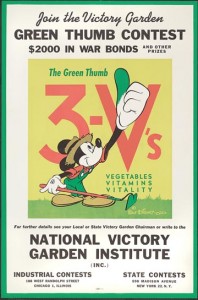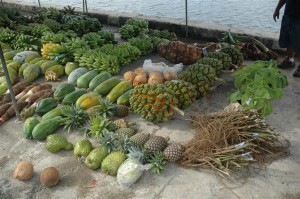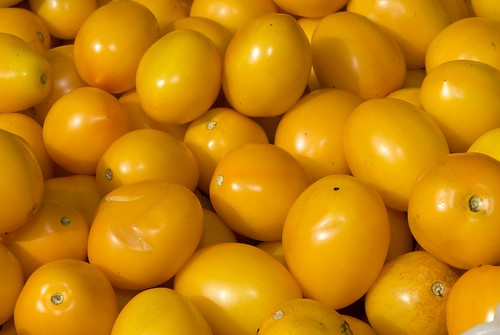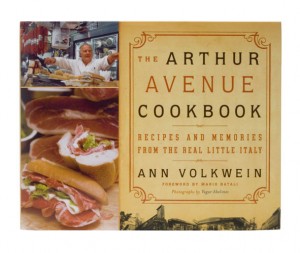Inside The New York Botanical Garden
Posted in Shop/Book Reviews, The Edible Garden on July 15 2009, by Plant Talk
 |
Richard Pickett is Director of Retail Operations. |
At your next family reunion picnic you may run into some long lost relatives. Perhaps you’d think distant cousins, twice removed on your mother’s side, but in fact Lazy Housewife, Radiator Charlie, and Collective Farm Woman are beans, tomatoes and melons, respectively, more likely to be found on your plate next to grandma’s famous potato salad than out back bobbing for apples or spitting watermelon seeds.
By definition, heirloom vegetables are vintage varieties that have been preserved by passing seeds down from generation to generation. Heirlooms have often been selected for taste, appearance, and eating quality, and the demand for heirloom vegetables is rapidly increasing, especially among gardeners looking for unique flavors and freshness. While many heirloom vegetables are now available at farm stands, varieties of tomatoes, beans, and cucumbers are the most popular.
Among edible heirlooms literally thousands of varieties are available, many handed down, others swapped with fellow gardeners, and a growing number purchased from the ever-expanding selection of specialty seed purveyors. For The Edible Garden, the Home Gardening Center’s Lois Loeb Vegetable Garden has been redesigned by Rosalind Creasy into New York’s best heirloom vegetable garden. Using seeds from Seed Savers Exchange, this garden features a bountiful array of beautiful and delicious heirloom vegetables, herbs, and edible flowers. Seed Savers Exchange is the foremost organization dedicated to preserving agricultural diversity through the preservation and sharing of heirloom seeds.
At Shop in the Garden, we offer a wide variety of heirloom seeds, exclusively from Seed Savers Exchange, as well a great selection of heirloom tomato, pepper, and eggplant seedlings. You can also find fabulous garden gear online. So whether you are a longtime heirloom vegetable advocate (and there are many) or simply a home gardener looking for more variety, flavor, and excitement in your harvest basket, give heirloom vegetables a try. Who knows, in our hectic day-to-day existence, it may just be time to find the Lazy Housewife in all of us.
Posted in Programs and Events, Science on July 14 2009, by Plant Talk
 The edible squashes have been a staple food in the Western Hemisphere for more than 5,000 years. The Aztecs and Mayas, as well as the Native Americans who met the Pilgrims, depended upon the squashes as one of the “three sisters” (corn, beans, squash) of early agriculture in the Americas.
The edible squashes have been a staple food in the Western Hemisphere for more than 5,000 years. The Aztecs and Mayas, as well as the Native Americans who met the Pilgrims, depended upon the squashes as one of the “three sisters” (corn, beans, squash) of early agriculture in the Americas.
Though squashes come in an amazing variety—from tender summer zucchini to hearty acorn squash and pumpkins—their great diversity comprises only five species: Cucurbita argyrosperma, Cucurbita ficifolia, Cucurbita maxima, Cucurbita moschata, and Cucurbita pepo. (Bottle gourds, thought by Swedish botanist Carl Linnaeus to belong to Cucurbita, are now placed in a separate genus, Lagenaria. They are useful for a variety of utensils and handicrafts, although not as good for eating.)
The domesticated species of Cucurbita were all derived from different wild ancestors—wild species that have survived droughts, pests, and diseases without care from people. Although the wild ancestors bear small, hard, bitter fruits, they are very valuable for breeding disease resistance into modern food plants.
Thomas Andres, co-founder of The Cucurbit Network and an Honorary Research Associate at the Botanical Garden, has worked for 30 years with Garden scientist Michael Nee, Ph.D., on squash research. Andres will present a Gallery Talk in the Britton Science Rotunda and Gallery on Friday, July 17, at 2 p.m. about his beloved topic. Following his talk is a behind-the-scenes tour of the William and Lynda Steere Herbarium to see how scientists identify and classify plants and to view some specimens of squashes and their relatives.
Space is limited, please call 718-817-8703 for reservations.
Posted in Gardening Tips on July 13 2009, by Sonia Uyterhoeven
 |
Sonia Uyterhoeven is Gardener for Public Education. Join her each weekend for home gardening demonstrations on a variety of topics in the Home Gardening Center. |
The best way to handle life’s ups and downs is to make a commitment to vertical gardening. I have, and it has always led me to new ideas and creative ways of growing my vegetables. Why garden vertically? With an annual vine, a clematis, or a climbing rose, it seems pretty obvious. So why not, then, bring this gardening technique into your vegetable garden?
Saving space is an obvious reason for growing vertically, but vertical crops are also easier to harvest and are less susceptible to diseases. The crop is lifted from its usual place on the ground where it fights for sunlight and good air circulation. I notice a big different in my cucumbers when I grow them up a tepee or a trellis versus letting them sprawl on the ground.
This year I will be experimenting with A-frames that have a grid or wire mesh on either one or both sides. I will be growing cucumbers up these structures, but I could just as well be trying melons, squashes, gourds, or tomatoes. (If you are growing a vegetable that will eventually produce heavy fruit, give the fruit extra support by either cradling them with an old pair of panty hose or a nylon or mesh support.)
I am more of a practical woman. What I like so much about these vertical frames is that there is space underneath that can be used to plant lettuce, beets, or any fast-growing crop that will capitalize on the good light while the vine is young and then adapt graciously to the part-shade that the vine eventually casts.
Read More
Posted in Exhibitions on July 10 2009, by Plant Talk
Garden trends come and go, but the edible garden, despite its changing names, has been a stable feature in American life.
 This summer, in conjunction with The Edible Garden summer-long exhibitions, the LuEsther T. Mertz Library presents a display featuring the “war” or “victory” garden, the movement inspired during the years of World War I (1917–18) and World War II (1941–45) when vegetable gardening became an act of patriotism as well as practicality. Citizens were encouraged to grow, can, and store crops to ensure self-sufficiency at home and to keep the nation’s distribution of food focused on our troops and allies.
This summer, in conjunction with The Edible Garden summer-long exhibitions, the LuEsther T. Mertz Library presents a display featuring the “war” or “victory” garden, the movement inspired during the years of World War I (1917–18) and World War II (1941–45) when vegetable gardening became an act of patriotism as well as practicality. Citizens were encouraged to grow, can, and store crops to ensure self-sufficiency at home and to keep the nation’s distribution of food focused on our troops and allies.
On display are brochures, photos, nursery seed catalogs, a musical score, and archival items that narrate and depict the Victory Garden movement that spanned the nation and, with government, business and community support, proved to be successful. One poster circa 1944 features Mickey Mouse pitching the Green Thumb Contest sponsored by the National Victory Garden Institute. From 1942 is a musical score, Swing that Hoe and Watch Your Garden Grow, by William Eben Tourjee.
The exhibit also highlights The New York Botanical Garden’s significant contribution to the national cause during the years of the Second World War, including images of the Garden’s own Victory Garden.
For more Edible Garden events and weekend activities, click here.
Posted in Learning Experiences on July 9 2009, by Plant Talk
Take Classes in Amagansett, Learn Veggie Gardening, and More!
 |
Duncan Himmelman, Ph.D., is Program Manager for Continuing Education. |
I decided to take advanced physics in the months between my junior and senior years in high school, sensing it would give me a slight edge in the college application process and that it would free up my senior year schedule to pursue extracurricular activities. My friends were aghast: “Nerd” had not yet been coined, but I was certainly viewed as the precursor. Yes, it was difficult, both the advanced physics and loss of fun times with friends and family, but it was taught in such an engaging manner that it galvanized my decision to pursue science in college. Summer school was the key to my future! Who knew?
Summer is the ideal time to take on an academic or leisure time educational pursuit. Continuing Education offers a diversity of programming this summer both here at the Garden and in such far flung places as Amagansett on Long Island. Located in the middle of summer-cottage country, the nearby beaches of Amagansett provide spectacular vistas from which to learn the fundamentals of drawing or watercolor painting. If art is not for you, then learn about garden design or growing roses using a totally organic approach. No matter what, combining the leisurely pace of summer life with a fun course or two can be just what the doctor ordered.
If you are staying closer to home, near the Garden, why not enroll in the one-day Vegetable Gardening for Beginners program on Saturday, July 18. In keeping with The Edible Garden celebration and with the current “grow your own garden” craze sweeping the nation, come get the fundamentals needed to grow a bunch of veggies, from soil preparation and seeding to garden maintenance using strictly organic methods. Summer school was never so much fun.
For those who are more serious-minded about summer school courses, consider signing up for one of the Summer Intensives offered in Botanical Art and Illustration or Floral Design. Located here at the Garden, you will be amazed at the many locations where you can gain inspiration for the Illustration courses and actually sit outdoors to draw. Floral Design, an intensive five-week program, brings you from basic floral techniques through the creative process of designing wedding and “grand scale” arrangements. Perhaps, like my physics summer school course, you’ll find it demanding, but it may also be the touchstone you’ve been waiting for!
Posted in People, Science on July 8 2009, by Plant Talk
 |
Wayne Law, Ph.D., is a Postdoctoral Research Associate who studies ecology, ethnobotany, and conservation in Micronesia. Come speak with him at our Café Scientifique on July 9, from 6 to 8 p.m., in the Conservatory Courtyard as part of The Edible Garden. |
 When someone asks you to visualize a banana, most people in the United States will picture the typical, slightly curved, yellow-skinned banana with a bland white flesh that can be found at local grocery stores. However, a number of different varieties exist: small bananas, straight bananas, red-skinned bananas, creamy-tasting bananas—even bananas that have a bright-orange flesh—and many of these varieties can be found on tiny islands in the Pacific known as Micronesia, where Botanical Garden scientists are conducting research.
When someone asks you to visualize a banana, most people in the United States will picture the typical, slightly curved, yellow-skinned banana with a bland white flesh that can be found at local grocery stores. However, a number of different varieties exist: small bananas, straight bananas, red-skinned bananas, creamy-tasting bananas—even bananas that have a bright-orange flesh—and many of these varieties can be found on tiny islands in the Pacific known as Micronesia, where Botanical Garden scientists are conducting research.
One of our goals in Micronesia is to record traditional plant knowledge that is the foundation of these islands’ unique cultures. The plant knowledge throughout this region is incredibly diverse as plants are integral to all aspects of daily island life, from the construction of houses and canoes to use as medicines and foods. As traditional ways of life are influenced by modern amenities, we are constantly seeing evidence that traditional plant knowledge is being lost and that many common items once made from nature are being replaced by plastic products that have an origin thousands of miles away. One study we conducted analyzed the knowledge of food plant varieties in Kosrae, the easternmost island of the Micronesia chain.
By the early 1900s, Kosrae, an island home to 7,000 people in the Eastern part of Micronesia, had already been exposed to French and Russian explorers, whalers, beachcombers, pirates, and traders, beginning the erosion of what had been a very traditional Pacific island lifestyle. At that time, Ernst Sarfet, a German ethnographer, documented much of Kosrae’s cultural aspects and plant uses during the Hamburg South Seas expedition, an impressive voyage that lasted two years and produced a 13-volume publication based on the observations made during the expedition. The translated work provides an early record of the different varieties of bananas, breadfruit, coconuts, pandanus, sugar cane, soft and hard taro, and yams. (The photo shows a display of some of the fruits and vegetables mentioned, during a holiday celebration in Kosrae.)
Read More
Posted in Exhibitions, The Edible Garden on July 7 2009, by Plant Talk
 Carol Capobianco is Editorial Content Manager at The New York Botanical Garden.
Carol Capobianco is Editorial Content Manager at The New York Botanical Garden.
Arthur Avenue.
Those two words conjure up so many sights, sounds, smells, and flavors all having to do with great food—Italian, that is.
As a kid growing up in the neighborhood I remember seeing round men with a napkin about their neck dousing raw clams with hot sauce and then slurping them down. I remember hearing the cacophony of clucking, caged chickens awaiting their turn with the butcher at the fresh poultry and rabbit market.
And the smells of the beloved “real Little Italy” were overwhelming and everywhere: fresh bread from the bakeries, sausage and peppers grilling at the street feasts, and from open apartment windows, tomato sauce (or “gravy” as we called it) simmering away.
But it was the flavors—and the quality—that are most reminiscent and what still brings me and countless others back to the area. The melt-in-your-mouth ravioli and fresh mozzarella, the sharp cheeses and imported prosciutto, the fine cuts of meat and the specialty fish, the incomparable breads and pastries, the strong espresso coffee.
And for those who don’t cook or who want to taste Italian food at its best in America, there are the restaurants, with menus filled with so many delicious meals that just reading the choices makes your mouth water. When I take my first bite into a dish made at these places, I can’t help but close my eyes and sigh with appreciation for these superior, soulful foods that can be savored right here in New York—and so close to The New York Botanical Garden.
Some of these delectables will be available for you to sample this Thursday from 6 to 9 p.m. at A Taste of Arthur Avenue, the first of seven Edible Evenings planned during The Edible Garden.
If you’d like to try your own hand at cooking some of the special dishes found on Arthur Avenue, you’ll find dozens of recipes in The Arthur Avenue Cookbook carried at Shop in the Garden.
Posted in Gardening Tips on July 6 2009, by Sonia Uyterhoeven
 |
Sonia Uyterhoeven is Gardener for Public Education. Join her each weekend for home gardening demonstrations on a variety of topics in the Home Gardening Center. |
 Have you ever observed the popular kids in school? They look stylish seemingly without having made an effort, are confident and outgoing, and always seem to surround themselves with beautiful people.
Have you ever observed the popular kids in school? They look stylish seemingly without having made an effort, are confident and outgoing, and always seem to surround themselves with beautiful people.
Vegetables are no different. Some of them are born with style while others struggle to cast off their utilitarian image. Some just have a universal appeal, others are easy to grow and never disappoint, while a select class can transform any second-rate chef into the next Jacques Pépin.
An Internet survey of the most popular homegrown vegetables in the country resulted in the following Top 10: tomatoes, peppers, cucumbers, onions, beans, lettuce, carrots, sweet corn, radishes and cabbage. (Reading the list just made me hungry.) How were the choices made?
Not surprisingly, tomatoes were at the top of the list—close to 90 percent of the population includes tomatoes in their vegetable garden. Both tomatoes and peppers are incredibly prolific—if you have space for only one plant you will get a nice harvest.
Tomatoes and peppers are also easy to buy as transplants at your local garden center or farmers market. The choices are always exquisite: Do you want an F1 Hybrid or an heirloom? Would you like a sweet pepper or hot pepper? What color would you like the fruit to be this year… yellow, purple, red, orange, or green?
Read More
Posted in Exhibitions, Programs and Events, The Edible Garden on July 3 2009, by Plant Talk
 |
Andrew Haight is Manager of the Everett Children’s Adventure Garden. |
Maps have always captured children’s imagination. Growing up I had every intention of becoming the next Indiana Jones. I hunted down buried “treasures” in my parent’s basement and made my own maps. I carefully crinkled the sheets, even tearing the corners to make the paper maps appear from “olden times.” The mystery and excitement seemed trapped on these sheets of paper; I felt they could lead me to new adventures.
This summer as part of The Edible Garden, maps will play a central role as we focus on the adventure in the Everett Children’s Adventure Garden through Flower Power!
Visitors can embark on their own journey through a series of activities laid out as a map inside each child’s field notebook. For instance, the map points out where a family can stop and make a pollinator puppet to take home and also guides children to several different activity and play stations, including a spot where they can mold their own flower out of clay.
The map allows children to choose their own route. Along the way they can discover the larger-than-life flower models, detour through Beth’s Maze, or simply take their time to explore each nook and cranny of the Garden. With the reins in each child’s hands in the form of a map, the possibilities are endless.
For more Edible Garden events and weekend activities, click here.
Posted in Exhibitions, The Edible Garden on July 2 2009, by Plant Talk
I’m a self-proclaimed minimalist. I don’t really know how it happened (a result, most likely, of having moved 16 times in the past 10 years), but it has permeated all parts of my life, including my kitchen. Despite that, I’ve always made space for some homegrown produce in my life—or on my windowsill, to be more precise. And having a garden to eat from is the basis of how I learned to cook, a reality that’s not easy for anyone. (It helps that my home region of Southern California is an agricultural utopia where nearly anything will grow anytime of year). And while I’ve never had enough space to sow a full garden, the idea of eating as fresh and as in season as possible has stuck with me.
With green, sustainable, and local as the buzzwords du jour, it can become intimidating figuring out how, if at all, it can work for you. All that moving I’ve done and all the creative ways people have embraced those tenets in my current hometown of San Francisco has led me to this conclusion: Make sure whatever you do works with your lifestyle, and you’ll be more likely to stick with it in the long term. There are plenty of resources out there for the gung ho: you can get a subscription to a CSA (Community Supported Agriculture), get a plot in a community garden, or just support your local farmer or grocer who you think is doing it right.
And, there’s a huge upside for the food obsessed—you and your family start to learn a lot about ingredients you once may have considered mundane (like that Brussels sprouts grow on stalks, that chickpeas are tasty fresh, that freshly grown cucumbers actually have taste, or even that kids will eat freshly picked tomatoes like candy once they’ve experienced how sweet they actually are).
Read More













